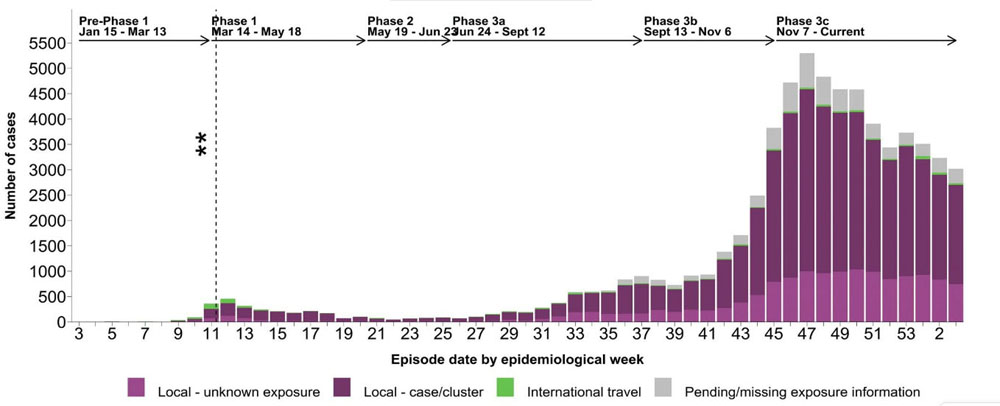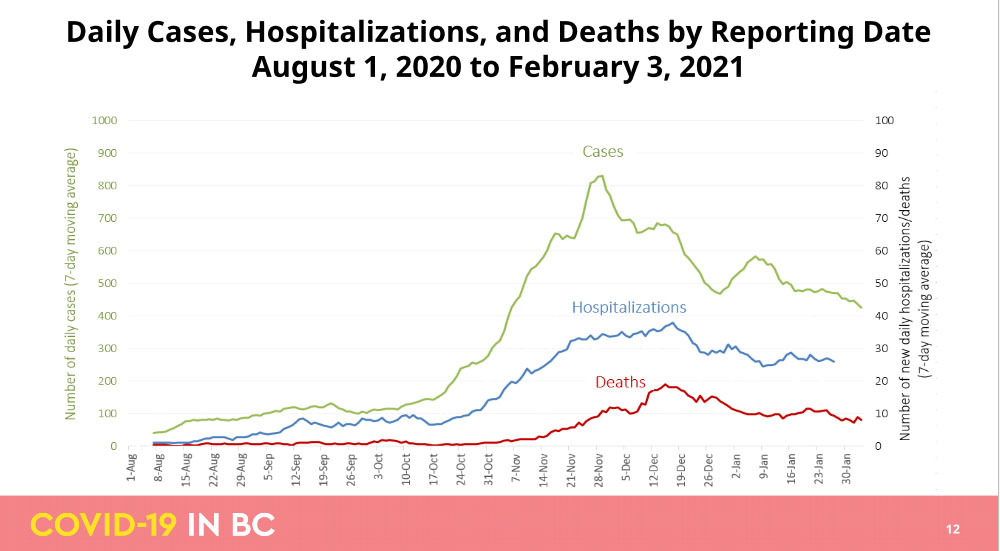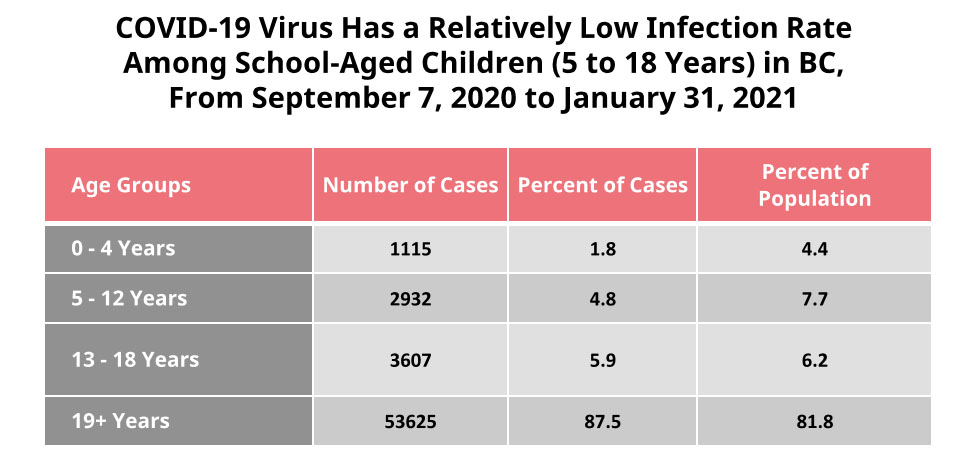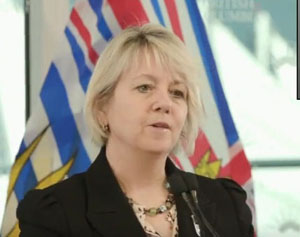
Friday February 5, 2021 | VICTORIA, BC [Last updated at 11:58 am]
by Mary P Brooke, B.Sc., Editor | Island Social Trends
Today an updated set of COVID-19 data modelling with data up to January 31 and early February was presented by Provincial Health Officer Dr Bonnie Henry by teleconference out of Vancouver. | Data Modelling Report at February 5, 2021
The peak for cases was in mid-November, with notable declines in previous hot spot areas in Fraser Health. Most spread is a result of social gatherings and workplace exposure, said Dr Henry today.
She mentioned the COVID virus variants being “of concern” (B117/UK and B1351/South Africa) which have led to increased transmission in a notable way in the United Kingdom, Portugal and Ireland, but are also found in BC. Dr Henry says the “increased severity of illness (from the variants) is very concerning”. The variants are more infectious. “We do not want to be in a situation of rapid growth (of cases)”.
The B117 has increased transmissability – RNA virus- single genomic sequence — doesn’t have a spell checker. Can lead to a virus to take over or spread faster, giving it an advantage. It’s worrisome, that in the past week there is increased evidence of B117 causing more severe illness.
There have been 28 detected incidents of infection by the variants: 19 by the UK variant (14 of which were directly related to travel, and the rest through direct contact with those travellers) and eight by the South African variant (with unknown location or means of exposure).
Maintaining the frontline health-care system:

Dr Henry reiterated that it is BC’s primary priority to reduce the number of cases and deaths in the older population, which takes pressure off the acute-care hospitalization system so that health care continues to be available to the fuller population. Immunization among long-term care residents is presently around 87 percent from a program that began in December, Dr Henry said today.
“But across the board, things are beginning to settle down,” she added.
Social gathering orders continue:
“Interactions need to continue to be safe,” said Dr Henry rate. Orders that were first put in place in mid-November for the lower mainland area (and extended a short time later to the full province) were set to expire at midnight tonight, February 5.
However, today Dr Henry announced that the orders prohibiting social gatherings will continue. “Right now we need to stay the path. We need to buy time,” she said toward the end of her presentation. She wants to see the immunization program back up and running at full speed. An increase in contacts with others can cause a setback, she explained.
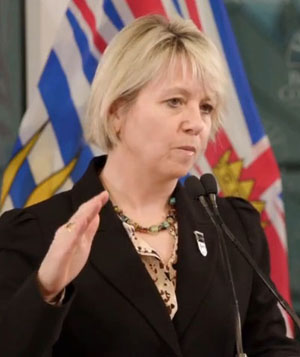
She highlights “no gatherings” other than immediate household, for SuperBowl this Sunday, or for Lunar New Year, Family Day Weekend, or Valentine’s Day.
“We may need to increase restrictions if variants begin to take off,” said Dr Henry today regarding social gatherings during the continuing pandemic. But if things remain under control, restrictions could be eased. She’s setting no deadline, “leaving it open-ended”.
There have been 547 cases just in Whistler alone due to social gatherings around skiing, said BC Health Minister Adrian Dix in today’s announcement. Vancouver Coastal Health will be making an announcement about this as well today. “This is too many.” Case counts are also concerning in Fernie, he said. “Make those communities and workplaces safer,” said Dix.
“It’s not the time to go to Whistler and party but day trips are okay,” said Dr Henry, as COVID spread continues.
Dix says that “the hard work of each of us has made a difference”, as evidenced in the modelling released today. “We bent our curve last spring only to see COVID fight back with all it’s might,” said Dix. He emphasized that the new variants are more infectious.
Vaccine safety:
So far in BC 55 people have had serious reactions to the mRNA COVID vaccines, said Dr Henry today. That’s out of a total of 205 “adverse reactions” in BC since the beginning of the immunization program.
COVID cases peaked in mid-November, now plateauing:
The seven-day moving average of new COVID cases in BC shows there was a peak in mid-November 2020, though counts are still high in this second wave in winter 2021.

Sources of COVID viral infection as found in BC cases are led by international travel, followed closely by local case/cluster and then local unknown exposure.
Observing COVID in Phases:
The BC Centre for Disease Control (BC CDC) is now identifying Phases of the pandemic. We are already now in Phase 3. Phase 3a covers June 24 to September 12, 2020, followed by Phase 3b in the fall of 2020 (Sept 13 to Nov 6), and currently Phase 3C (from Nov 7 to current).
Previous to all that was pre-Phase 1 (Jan 15 to March 13 in 2020 before the pandemic was officially declared in BC), followed by Phase 1 (March 14 to May 18, 2020 in which much of BC was in relative lockdown), and then Phase 2 (May 19 to June 23, 2020 as society and the economy began to open up) in which case counts were low compared to now.
Distribution of cases in South Vancouver Island:
COVID cases on South Vancouver Island as of January 31, 2021 (one year of pandemic, since January 2020): Victoria Core 290; Saanich Peninsula 87; Western Communities 80; Cowichan Valley South 304; Cowichan Valley North 51; Cowichan Valley West 17.
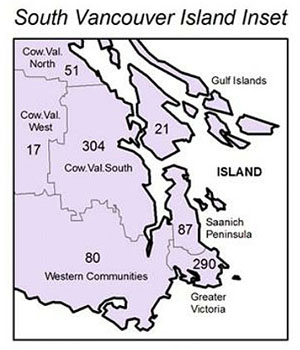
As well, there are variants in California to the south of us, which Dr Henry is keeping an eye on.
We are dependent on essential goods and services from other parts of the continent, which makes “COVID zero” more of a challenge for BC due to the travel of essential workers across the border.
Case counts by age in BC :
Starting in mid-November 2020 the count of test-positive COVID-19 cases in BC began to skyrocket. That’s when people began socializing more, especially around holidays like Thanksgiving, Halloween, followed by Christmas and New Year.
More orders restricting social gatherings were brought in mid-November to try and curtail this.
The highest case counts are seen in working-age adults, from age 20 to 59 years. Yet these are the age groups being left to almost last in the BC Immunization Plan as released in January 2021, even though they are potentially spreading a lot of the infection (while possibly not experiencing severe symptoms themselves).
Hospitalizations and Deaths:
There is a declining relationship between cases numbers, the number of hospitalizations, and the number of deaths due to COVID-19 infection in BC.
Cases peaked in mid-November, while hospitalizations and deaths have so far peaked around mid-December. None of these statistics have fallen below levels that were seen in late October to early November.
Infection rate in children:
The BC CDC data presents a profile of COVID-19 infection in children as being “relatively low”. For example, the percent of cases in the 5 to 12 year age group is 4.8 percent, while children in that age grouping comprise 7.7 percent of the general population; that is a population mostly attending in elementary and early middle school years.
For children up to age four, the gap is wider. COVID cases are 1.8 percent of the total count in BC, while children age 0 to 4 years are 4.4 percent of the general population.
It should be noted, however, that these are test-positive cases. Provincial Health Officer Dr Bonnie Henry has frequently stated that children tend not to show symptoms if infected and may not show any evidence of illness. Those children would not be included in the case count.
The case counts for ages 13 to 18 years make up 5.9 percent of all cases, close to the 6.2% population level of that age group in the overall population.
For youth who are 19-years-old, their case percentage is 87.5, which surpasses their 81.8 percent count in the total population.
===== LINKS:
BC CDC COVID Data Modelling report at February 5, 2021 [link to PDF]
Public Health Orders during the COVID pandemic (BC Health)




